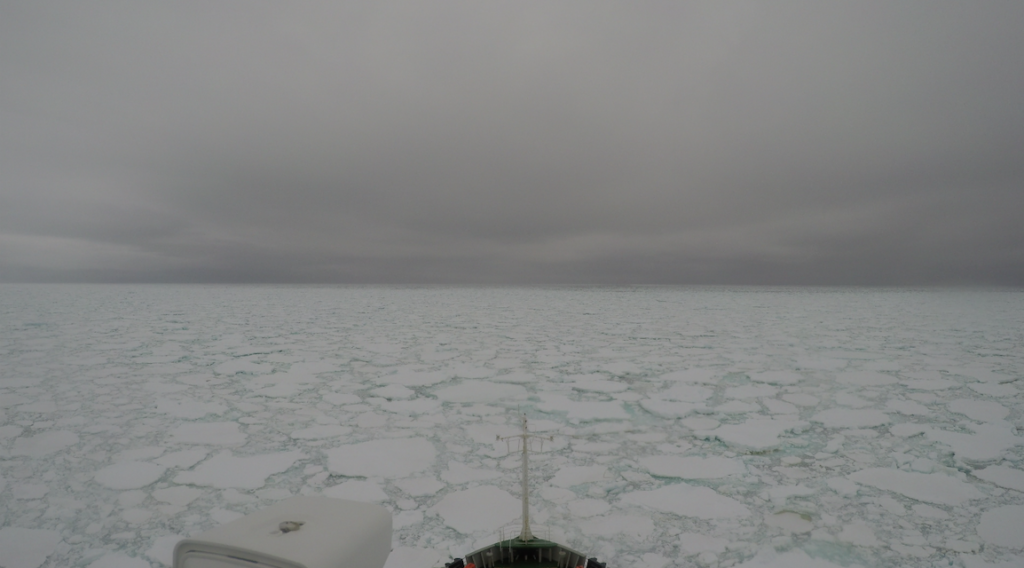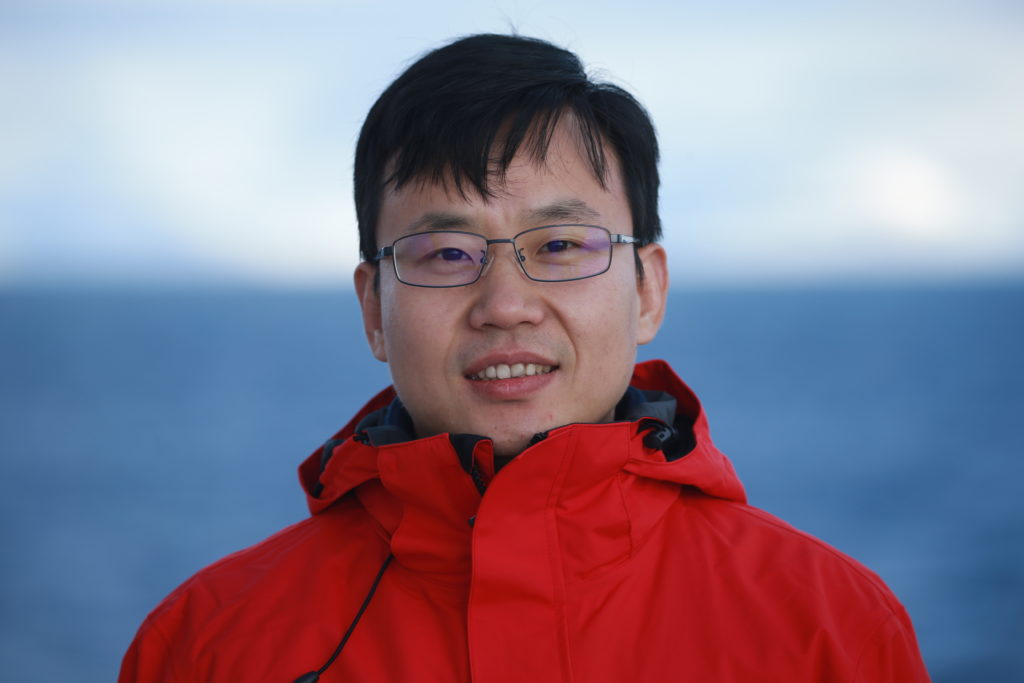
story from Helen Hill for MITgcm
Towards reconstructing long-term Antarctic sea-ice thickness and volume through sea-ice data assimilation.
A team of researchers from China and the US has created a new atmospheric ensemble forcing for MITgcm to improve the accuracy and the uncertainty estimation of Antarctic sea ice simulation.
Finding filter divergence in Antarctic sea ice data assimilation partially caused by using the ERA5 ensemble as the atmospheric forcing (Luo et al., 2021), Hao Luo, Qinghua Yang, and Dake Chen, from the School of Atmospheric Sciences, Sun Yat-sen University, and Southern Marine Science and Engineering Guangdong Laboratory (Zhuhai), China, and Matthew Mazloff at SCRIPPS have developed a multivariate balanced atmospheric ensemble forcing for a regional Southern Ocean sea ice–ocean coupled implementation of MITgcm. A paper describing their work is recently published in Geophysical Research Letters.
“Antarctic sea ice plays an important role in the climate system but highly non-linear physics character makes the simulation difficult”, explains Qinghua Yang. “We successfully established the Data Assimilation System for the Southern Ocean (DASSO) based on MITgcm in 2021 which can provide improved estimates of both sea-ice concentrations (SIC) and sea-ice thicknesses (SIT). However, the simulation uncertainty of Antarctic sea ice is underestimated when using the ERA5 ensemble as the atmospheric forcing directly”. Seeking out a solution to improving the uncertainty estimation of sea ice simulation prompts the team’s search for an improved atmospheric ensemble forcing.
“Although there are many model perturbation methods for estimating the simulation uncertainty, we choose to perturb the atmospheric forcing because of its strong influence on Antarctic sea ice, as well as considering the dynamic consistency of model states” explains Qinghua Yang. “We generated a balanced atmospheric ensemble forcing by applying the multivariate empirical orthogonal function and a first-order Markov chain model to the high-frequency ERA5 reanalysis.”
To validate the performance of the new atmospheric forcing, the team conducted experiments from 1 January 2016 to 28 February 2017. In general, the newly generated atmospheric forcing can suppress model errors of SIC and produce better estimates of simulation uncertainties. Further analysis reveals the improvement stems from a better representation of atmosphere-ocean and sea ice-ocean thermodynamic processes in the model.
Yang says, “Our results demonstrate the importance of a balanced atmospheric ensemble forcing for sea ice-ocean coupled model in the Southern Ocean, which lays the foundation for further optimization of DASSO through better estimations of background error and observation error.”
To find out more about this work contact Qinghua Yang
Story image credit: Jian Liu, Southern Marine Science and Engineering Guangdong Laboratory (Zhuhai)
About the Researcher

Qinghue Yang began using MITgcm in 2009. “With MITgcm, my colleagues and I have built the first Chinese Arctic Sea Ice Prediction System in 2010, and we started to offer sea ice service for the Chinese Arctic and Antarctic expedition cruises since 2010.,” he says.” Now we still use MITgcm in the Arctic and Antarctic sea ice-ocean numerical modeling, data assimilation and prediction.”
This Month’s Featured Publication
- Luo, H., and Coauthors (2023), A balanced atmospheric ensemble forcing for sea ice modeling in Southern Ocean, Geophys. Res. Lett., doi: 10.1029/2022GL101139
Related Publication
- Hao Luo, Qinghua Yang, Longjiang Mu, Xiangshan Tian-Kunze, Lars Nerger, Matthew Mazloff, Lars Kaleschke and Dake Chen (2021), DASSO: a data assimilation system for the Southern Ocean that utilizes both sea-ice concentration and thickness observations, Journal of Glaciology, doi: 10.1017/jog.2021.57
Other New Publications last month
Haijin Cao et al (2023), Towards the Upper-Ocean Unbalanced Submesoscale Motions in the Oleander Observations, Journal of Physical Oceanography, doi: 10.1175/JPO-D-22-0134.1
Yuhan Cao et al (2023), Global Sea Surface Cyclogeostrophic Currents Derived from Satellite Altimetry Data, JGR Oceans, doi: 10.1029/2022JC019357
Alan Condron (2023), Towing icebergs to arid regions to reduce water scarcity, Scientific Reports, doi: 10.1038/s41598-022-26952-y
Louis-Philippe Coulombe et al (2023), A broadband thermal emission spectrum of the ultra-hot Jupiter WASP-18b, arXiv: 2301.08192 [astro-ph.EP]
Yan Du et al (2023), Multi-scale ocean dynamical processes in the Indo-Pacific Convergence Zone and their climatic and ecological effects Earth-Science reviews, doi: 10.1016/j.earscirev.2023.104313
B. D. Dushaw, D. Menemenlis (2023), Resonant Diurnal Internal Tides in the North Atlantic, Part II: Modeling, Geophysical Research Letters, doi: 10.1029/2022GL101193
Severine Fournier et al (2023), Quantification of Aquarius, SMAP, SMOS and Argo-Based Gridded Sea Surface Salinity Product Sampling Errors, Remote Sensing, doi: 10.3390/rs15020422
Gong, Y. et al (2023), An internal solitary wave forecasting model in the northern South China Sea (ISWFM-NSCS), Geosci. Model Dev. Discuss., doi: 10.5194/gmd-2022-287
Nicolas Gonzalez et al (2023), Understanding tidal mixing at the Strait of Gibraltar: A high-resolution model approach, Progress in Oceanography, doi: 10.1016/j.pocean.2023.102980
Larry Thomas Gulliver and Timour Radko (2023), Virtual laboratory experiments on the interaction of a vortex with small-scale topography, Physics of Fluids, doi: 10.1063/5.0136723
Jing He and Michael D. Tyka (2023), Limits and CO2 equilibration of near-coast alkalinity enhancement, Biogeosciences, doi: 10.5194/bg-20-27-2023
Minghai Huang et al (2023), Seasonal Eddy Variability in the Northwestern Tropical Atlantic Ocean, Journal of Physical Oceanography, doi: 10.1175/JPOD-22-0200.1
Kalnay, E. et al (2023), Towards Strongly-coupled Ensemble Data Assimilation with Additional Improvements from Machine Learning, Nonlin. Processes Geophys. Discuss., doi: 10.5194/npg-2023-1
Peter N. Mikhalevsky et al (2023), Deep ocean long-range underwater navigation with ocean circulation model corrections, The Journal of the Acoustical Society of America, doi: 10.1121/10.0016890
Bin Mu et al (2023), IceTFT v 1.0.0: Interpretable Long-Term Prediction of Arctic Sea Ice Extent with Deep Learning, Geoscientific Model Development, doi: 10.5194/gmd-2022-293
Christopher G. Piecuch (2023), River effects on sea-level rise in the Río de la Plata estuary during the past century, Ocean Sciences, doi: 10.5194/os-19-57-2023
María Concepción Calero Quesada (2022), Method for Studying the Feasibility of Sea Currents as a Source of Renewable Energy in Hydrodynamic Systems Likely to be Used. Special cases in the south of the Iberian Peninsula, Doctoral Thesis University of Malaga, Spain, https://riuma.uma.es/xmlui/bitstream/handle/10630/25334/TD_CALERO_QUESADA_Maria_Concepcion.pdf
Ran, G. et al (2023), Development of a Three-Dimensional Hydrodynamic Model Based on the Discontinuous Galerkin Method, Water, doi: 10.3390/w15010156
Song, X. (2023), Observed opposite fall-to-winter variations in the air-sea latent heat flux between the western boundary currents and coastal seas, Geophysical Research Letters, doi: 10.1029/2022GL100875
Sukhonos, P.A., Evstigneev, V.P. (2023). Analysis of the Non-Gaussianity of the Sea Surface Temperature in the North Atlantic Based on Reanalysis Data. In: Chaplina, T. (eds) Processes in GeoMedia—Volume VI. Springer Geology. Springer, Cham. https://doi.org/10.1007/978-3-031-16575-7_57
Heriberto J. Vazquez, et al (2023), Impact of Yucatan Channel Subsurface Velocity Observations on the Gulf of Mexico State Estimates, Journal of Physical Oceanography, doi: 10.1175/JPO-D-21-0213.1
Yujuan Wang et al (2023), Climate-driven changes of global marine mercury cycles in 2100, PNAS, doi: 10.1073/pnas.2202488120
Hong-sheng Zhang et al (2023), Comparison of the Characteristics of Internal Wave Propagation under Two Surface-Boundary Conditions in Continuously Density-Stratified Oceans, Journal of Coastal Research, doi: 10.2112/JCOASTRES-D-22-00058.1
Do you have news about research using MITgcm? We are looking for contributions to these pages. If you have an interesting MITgcm project (ocean, atmosphere, sea-ice, physics, biology or otherwise) that you want to tell people about, get in touch. To make a post, contact Helen
